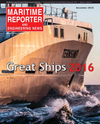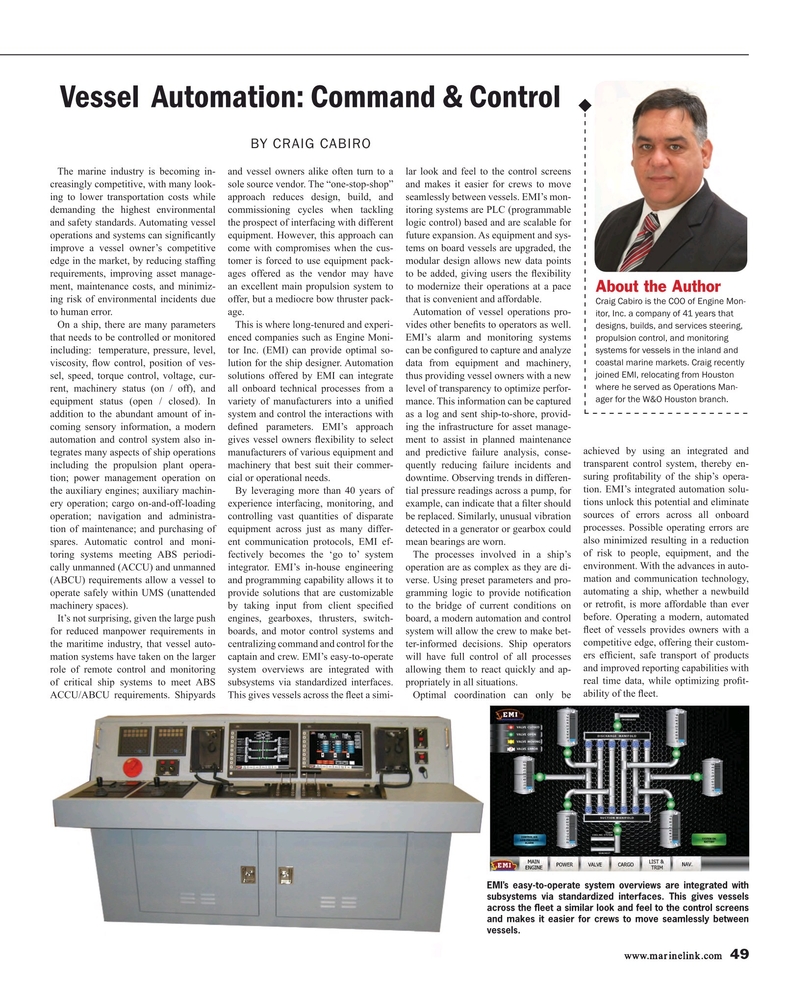
Page 49: of Maritime Reporter Magazine (December 2016)
Great Ships of 2016
Read this page in Pdf, Flash or Html5 edition of December 2016 Maritime Reporter Magazine
Vessel Automation: Command & Control
BY CRAIG CABIRO
The marine industry is becoming in- and vessel owners alike often turn to a lar look and feel to the control screens creasingly competitive, with many look- sole source vendor. The “one-stop-shop” and makes it easier for crews to move ing to lower transportation costs while approach reduces design, build, and seamlessly between vessels. EMI’s mon- demanding the highest environmental commissioning cycles when tackling itoring systems are PLC (programmable and safety standards. Automating vessel the prospect of interfacing with different logic control) based and are scalable for operations and systems can signi? cantly equipment. However, this approach can future expansion. As equipment and sys- improve a vessel owner’s competitive come with compromises when the cus- tems on board vessels are upgraded, the edge in the market, by reducing staf? ng tomer is forced to use equipment pack- modular design allows new data points requirements, improving asset manage- ages offered as the vendor may have to be added, giving users the ? exibility ment, maintenance costs, and minimiz- an excellent main propulsion system to to modernize their operations at a pace
About the Author ing risk of environmental incidents due offer, but a mediocre bow thruster pack- that is convenient and affordable.
Craig Cabiro is the COO of Engine Mon- to human error. age. Automation of vessel operations pro- itor, Inc. a company of 41 years that
On a ship, there are many parameters This is where long-tenured and experi- vides other bene? ts to operators as well. designs, builds, and services steering, that needs to be controlled or monitored enced companies such as Engine Moni- EMI’s alarm and monitoring systems propulsion control, and monitoring systems for vessels in the inland and including: temperature, pressure, level, tor Inc. (EMI) can provide optimal so- can be con? gured to capture and analyze coastal marine markets. Craig recently viscosity, ? ow control, position of ves- lution for the ship designer. Automation data from equipment and machinery, joined EMI, relocating from Houston sel, speed, torque control, voltage, cur- solutions offered by EMI can integrate thus providing vessel owners with a new where he served as Operations Man- rent, machinery status (on / off), and all onboard technical processes from a level of transparency to optimize perfor- ager for the W&O Houston branch. equipment status (open / closed). In variety of manufacturers into a uni? ed mance. This information can be captured addition to the abundant amount of in- system and control the interactions with as a log and sent ship-to-shore, provid- coming sensory information, a modern de? ned parameters. EMI’s approach ing the infrastructure for asset manage- automation and control system also in- gives vessel owners ? exibility to select ment to assist in planned maintenance achieved by using an integrated and tegrates many aspects of ship operations manufacturers of various equipment and and predictive failure analysis, conse- including the propulsion plant opera- machinery that best suit their commer- quently reducing failure incidents and transparent control system, thereby en- suring pro? tability of the ship’s opera- tion; power management operation on cial or operational needs. downtime. Observing trends in differen- the auxiliary engines; auxiliary machin- By leveraging more than 40 years of tial pressure readings across a pump, for tion. EMI’s integrated automation solu- ery operation; cargo on-and-off-loading experience interfacing, monitoring, and example, can indicate that a ? lter should tions unlock this potential and eliminate operation; navigation and administra- controlling vast quantities of disparate be replaced. Similarly, unusual vibration sources of errors across all onboard tion of maintenance; and purchasing of equipment across just as many differ- detected in a generator or gearbox could processes. Possible operating errors are also minimized resulting in a reduction spares. Automatic control and moni- ent communication protocols, EMI ef- mean bearings are worn. toring systems meeting ABS periodi- fectively becomes the ‘go to’ system The processes involved in a ship’s of risk to people, equipment, and the environment. With the advances in auto- cally unmanned (ACCU) and unmanned integrator. EMI’s in-house engineering operation are as complex as they are di- mation and communication technology, (ABCU) requirements allow a vessel to and programming capability allows it to verse. Using preset parameters and pro- operate safely within UMS (unattended provide solutions that are customizable gramming logic to provide noti? cation automating a ship, whether a newbuild machinery spaces). by taking input from client speci? ed to the bridge of current conditions on or retro? t, is more affordable than ever
It’s not surprising, given the large push engines, gearboxes, thrusters, switch- board, a modern automation and control before. Operating a modern, automated ? eet of vessels provides owners with a for reduced manpower requirements in boards, and motor control systems and system will allow the crew to make bet- the maritime industry, that vessel auto- centralizing command and control for the ter-informed decisions. Ship operators competitive edge, offering their custom- mation systems have taken on the larger captain and crew. EMI’s easy-to-operate will have full control of all processes ers ef? cient, safe transport of products and improved reporting capabilities with role of remote control and monitoring system overviews are integrated with allowing them to react quickly and ap- real time data, while optimizing pro? t- of critical ship systems to meet ABS subsystems via standardized interfaces. propriately in all situations.
ACCU/ABCU requirements. Shipyards This gives vessels across the ? eet a simi- Optimal coordination can only be ability of the ? eet.
EMI’s easy-to-operate system overviews are integrated with subsystems via standardized interfaces. This gives vessels across the

 48
48

 50
50
